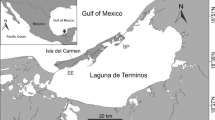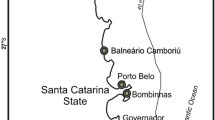Abstract
The importance of epibiosis in Antarctic benthic communities is highlighted here considering the specific diversity of sponges living on shells of the scallop Adamussium colbecki and on spines of the cidaroid urchin Ctenocidaris perrieri. Scallops are from three different areas along the Victoria Land [Tethys Bay (TB), New Harbour (NH), Dunlop Island (DI)], while cidaroid urchins are from NH but not present in the two other stations. Homaxinella balfourensis is the commonest species both on the scallops and cidaroid urchins. Other common species on scallops are Myxilla (Myxilla) asigmata, Lissodendoryx (Ectyodoryx) nobilis and Iophon unicorne at NH, Iophon unicorne at DI, and Iophon radiatum, Haliclona sp. 1, Iophon unicorne and Lissodendoryx (Ectyodoryx) nobilis at TB. The highest number of sponge species we found on a single scallop was ten and the sample was collected at NH. On the spines of C. perrieri, Isodictya erinacea, Iophon unicorne and Haliclona (Rhizoniera) dancoi are present too. A. colbecki and C. perrieri, generally living on soft bottoms, represent important substrata for several sponge species. In this way, sponges may increase their dispersal exploiting valves and spines as stepping stones.









Similar content being viewed by others
References
Barnes DKA, Clarke A (1995) Epibiotic communities on sublittoral macroinvertebrates at Signy Island, Antartica. J Mar Biol Assoc UK 75:689–703
Berkman PA (1994) Epizoic zonation on growing scallop shells in McMurdo Sound Antarctica. J Exp Mar Biol Ecol 179:49–67
Brueggeman P (1998) Cnidaria—Anthozoa: anemones, soft coral. In: Underwater field guide to Ross Island and McMurdo Sound, Antarctica: Paper 40. http://repositories.cdlib.org/sio/lib/mcm/40
Bruno JF, Bertness MD (2001) Habitat modification and facilitation in benthic marine communities. In: Bertness MD, Gaines SD, Hay ME (eds) Marine community ecology. Sinauer Associates, Sunderland, pp 201–218
Campos M, Mothes B, Veitenheimer Mendes IL (2007) Antarctic sponges (Porifera, Demospongiae) of the South Shetland Islands and vicinity. Part I. Spirophorida, Astrophorida, Hadromerida, Halichondrida and Haplosclerida. Rev Bras Zool 24:687–708
Caruso T, Falciai L, Zupo V (2005) Do hermit crabs like living in sponges? Paguristes eremita and Suberites domuncula: biometric data from the southern Mediterranean Sea. J Mar Biol Assoc UK 85:1353–1357
Cattaneo-Vietti R, Chiantore MC, Albertelli G, Cormaci M, Di Geronimo I, Gambi MC (1999) Spatial and vertical distribution of benthic littoral communities in Tethys Bay. In: Faranda FM, Guglielmo L, Ianora A (eds) Ross Sea ecology: Italian Antarctic expeditions (1986–1995). Springer, Berlin, pp 503–514
Cattaneo-Vietti R, Bavestrello G, Cerrano C, Pansini M, Mazzella L, Sarà M (2000) The role of sponges of Tethys Bay ecosystem. In: Faranda FM (ed) Benthic ecology of Tethys Bay. Springer, Berlin, pp 539–549
Cerrano C, Bavestrello G, Calcinai B, Cattaneo-Vietti R, Sarà A (2000a) Asteroids eating sponges from Tethys Bay, East Antarctica. Antarctic Sci 12:425–426
Cerrano C, Bavestrello G, Puce S, Chiantore M (2000b) Unusual trophic strategies of Hydractinia angusta (Cnidaria, Hydrozoa) from Tethys Bay, Antarctica. Polar Biol 23:488–494
Cerrano C, Puce S, Chiantore M, Bavestrello G, Cattaneo-Vietti R (2001) The influence of the epizoic hydroid Hydractinia angusta on the recruitment of the Antarctic scallop Adamussium colbecki. Polar Biol 24:577–581
Cerrano C, Calcinai B, Bertolino M, Valisano L, Bavestrello G (2006) Epibionts of the scallop Adamussium colbecki in the Ross Sea, Antarctica. Chem Ecol 22:235–244
Cerrano C, Calcinai B, Di Camillo CG, Valisano L, Bavestrello G (2007) How and why do sponges incorporate foreign material? Strategies in Porifera. In: Custódio MR, Hajdu E, Lôbo-Hajdu G, Muricy G (eds) Porifera research: biodiversity, innovation and sustainability. Museu Nacional, Rio de Janeiro, pp 239–246
Chernoff H (1987) Factors affecting mortality of the scallop Chlamys asperrima (Lamarck) and its epizooic sponges in South Australian waters. J Exp Mar Biol Ecol 109:155–171
Connell JH, Keough MJ (1985) Disturbance and patch dynamics of subtidal marine animals on hard substrata. In: Pickett STA, White PS (eds) The ecology of natural disturbance and patch dynamics. Academic, New York, pp 125–151
Corriero G, Pronzato R (1987) Epibiontic sponges on the bivalve Pinna nobilis. Mar Ecol Prog Ser 35:75–82
Corriero G, Pronzato R, Sarà M (1991) The sponge fauna associated with Arca noae L. (Mollusca, Bivalva). In: Reitner J, Keupp H (eds) Fossil and recent sponges. Springer, Berlin, pp 395–403
Cummings VJ, Thrush SF, Norkko A, Andrew NL, Hewitt JE, Funnell GA, Schwarz A-M (2006) Accounting for local scale variability in benthos: implications for future assessments of latitudinal trends in the coastal Ross Sea. Antarct Sci 18:633–644
Dayton PK (1972) Toward an understanding of community resilience and the potential effects of enrichments to the benthos at McMurdo Sound, Antarctica. In: Proceedings of the colloquium on conservation problems in Antarctica, Allen press, Lawrence, pp 81–96
Dayton PK, Oliver JS (1977) Antarctic soft-bottom benthos in oligotrophic and eutrophic environments. Science 197:55–58
Dubois P, Ameye L (2001) Regeneration of spines and pedicellariae in echinoderms: a review. Microsc Res Tech 55:427–437
Gili JM, Abellò P, Villanueva R (1993) Epibionts and intermoult duration in the crab Bathynectes piperitus. Mar Ecol Prog Ser 98:107–113
Guidetti M, Marcato S, Chiantore MC, Patarnello T, Albertelli G, Cattaneo-Vietti R (2006) Exchange between populations of Adamussium colbecki (Mollusca: Bivalvia) in the Ross Sea. Antarct Sci 18:645–653
Gutièrrez JL, Jones CG, Strayer DL, Iribarne OO (2003) Mollusks as ecosystem engineers: the role of shell production in aquatic habitats. Oikos 101:79–90
Gutt J, Schickan T (1998) Epibiotic relationship in the Antarctic benthos. Antarct Sci 10:398–405
Heilmayer O, Honnen C, Jacob U, Chiantore MC, Cattaneo-Vietti R, Brey T (2005) Temperature effects on summer growth rates in the Antarctic scallop, Adamussium colbecki. Polar Biol 28:523–527
Heterier V, David B, De Ridder C, Rigaud T (2008) Ectosymbiosis is critical factor in the local benthic biodiversity of the Antarctic deep sea. Mar Ecol Prog Ser 364:67–76
Jacob U (2001) Okologie der cidaroiden Seeigel des Weddellmeeres. Thesis, Bremen University, Bremen
Jacob U, Terpstra S, Brey T (2003) High-Antarctic regular sea urchins—the role of depth and feeding in niche separation. Polar Biol 26:99–104
Jones CG, Lawton JH, Shachak M (1994) Organisms as ecosystem engineers. Oikos 69:373–386
Linse K, Walker LJ, Barnes DKA (2008) Biodiversity of echinoids and their epibionts around the Scotia Arc, Antarctica. Antarct Sci 20:227–244
McClintock JB (1994) Trophic biology of antarctic echinoderms. Mar Ecol Prog Ser 111:191–202
McClintock JB, Amsler CD, Baker BJ, van Soest RWM (2005) Ecology of Antarctic marine sponges: an overview. Integr Comp Biol 45:359–368
Norkko J, Norkko A, Thrush SF, Cummings VJ (2005) Detecting growth under environmental extremes: spatial and temporal patterns in nucleic acid ratios in two Antarctic bivalves. J Exp Mar Biol Ecol 326:144–156
Potthoff M, Johst K, Gutt J (2006) How to survive as a pioneer species in the Antarctic benthos: minimum dispersal distance as a function of lifetime and disturbace. Polar Biol 29:543–551
Sarà M, Balduzzi A, Barbieri M, Bavestrello G, Burlando B (1992) Biogeographic traits and checklist of Antarctic demosponges. Polar Biol 12:559–585
Schejter L, Bremec C (2007) Benthic richness in the Argentine continental shelf: the role of Zygochlamys patagonica (Mollusca: Bivalvia: Pectinidae) as settlement substrate. J Mar Biol Assoc UK 87:917–925
Schejter L, Calcinai B, Cerrano C, Bertolino M, Pansini M, Giberto D, Bremec C (2006) Porifera from the Argentine Sea: diversity in Patagonian scallop beds. Ital J Zool 73:373–385
Schiaparelli S, Linse K (2006) A reassessment of the distribution of the common Antarctic scallop Adamussium colbecki (Smith, 1902). Deep Sea Res II Top Stud Oceanogr 53:912–920
Seiler J, Gutt J (2007) Can dead sponges still talk? Antarct Sci 19:337–338
Skinner DNB (1983) The geology of Tethys Bay. In: Oliver RL, James PR, Jago JB (eds) Antarctic earth sciente IV international symposium. Cambridge University Press, Cambridge, pp 150–155
Stockton WL (1984) The biology and ecology of the epifaunal scallop Adamussium colbecki on the west side of McMurdo Sound, Anarctica. Mar Biol 78:171–178
Vacchi M, Cattaneo-Vietti R, Chiantore M, Dalù M (2000) Predator-prey relationship between nototheniid fish Trematomus bernacchii and Antarctic scallop Adamussium colbecki at Tethys Bay (Ross Sea). Antarct Sci 12(1):64–68
Ward MA, Thorpe JP (1991) Distribution of encrusting bryozoans and other epifauna on the subtidal bivalve Chlamys opercularis. Mar Biol 110:253–259
Williams JD, McDermott JJ (2004) Hermit crab biocoenoses: a worldwide review of the diversity and natural history of hermit crab associates. J Exp Mar Biol Ecol 305:1–128
Zar JH (1984) Biostatistical analysis, 2nd edn. Prentice Hall, Englewood Cliffs, 718p
Acknowledgments
This research has been carried out thanks to the financial support of PNRA (Italian Antarctic Research Programme) fund of Italian Government and the New Zealand Ministry of Fisheries, project ZBD200201. The authors wish to thank Antarctica New Zealand for logistical support, in particular the whole staff of the K081 event. Thanks also to Riccardo Cattaneo-Vietti (Genoa University) for the opportunity offered to CC to participate in the expedition.
Author information
Authors and Affiliations
Corresponding author
Rights and permissions
About this article
Cite this article
Cerrano, C., Bertolino, M., Valisano, L. et al. Epibiotic demosponges on the Antarctic scallop Adamussium colbecki (Smith, 1902) and the cidaroid urchins Ctenocidaris perrieri Koehler, 1912 in the nearshore habitats of the Victoria Land, Ross Sea, Antarctica. Polar Biol 32, 1067–1076 (2009). https://doi.org/10.1007/s00300-009-0606-5
Received:
Revised:
Accepted:
Published:
Issue Date:
DOI: https://doi.org/10.1007/s00300-009-0606-5




